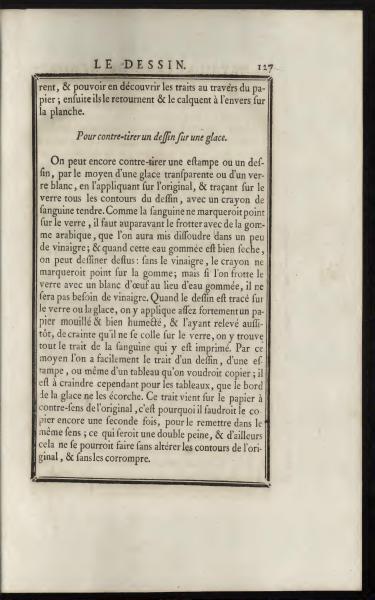DRAWING.
... and to be able to discover the lines through the paper; then they turn it over and trace it in reverse onto a plate.
For transferring a drawing onto glass.
One can also transfer a print or a drawing by using a transparent glass or white glass, applying it over the original, and tracing all the outlines of the drawing with a soft sanguine pencil. As sanguine would not mark on the glass, it must first be rubbed with gum arabic, dissolved in a little vinegar; and when this gum water is dry, one can draw on it: without the vinegar, the pencil would not mark on the gum; but if the glass is rubbed with an egg white instead of gum water, vinegar is not needed. When the drawing is traced on the glass or mirror, a damp and well-moistened paper is applied strongly to it, and quickly removed, lest it should stick to the glass, whereupon one finds all the lines of the sanguine transferred. By this method, one can easily obtain the outline of a drawing, a print, or even a painting one wishes to copy; however, it is feared with paintings, that the edge of the glass might scratch them. This imprint appears on paper in reverse of the original, for which reason it needs to be copied again, to restore it to the same direction; which would be a double workload, and besides, it cannot be done without altering the contours of the original, and corrupting them.
Translation Notes
Sanguine: A type of drawing material made from reddish-brown chalk or clay.
Gum Arabic: A natural gum made from the hardened sap of acacia trees, used as a binder in paint.
The text explains a method for transferring a drawing onto glass using a transparent medium and a sanguine pencil. It involves applying gum arabic or egg white to the glass surface and using moist paper to capture the drawing. The process includes reversing the image, which might require copying it again to restore the original orientation.
